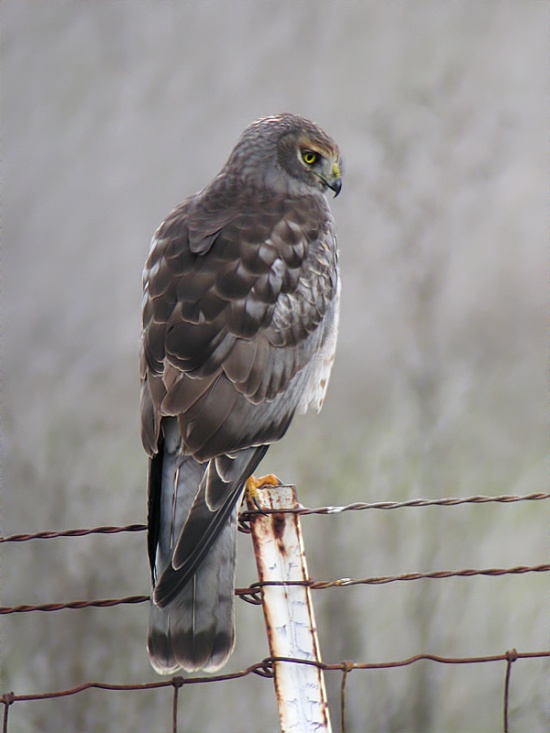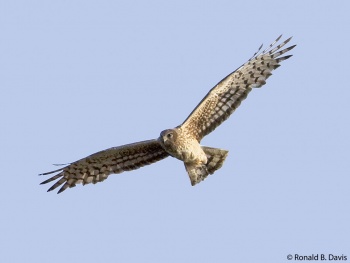(Picture placement) |
Nutcracker (talk | contribs) (Clements finally get their act together on splitting this) |
||
| Line 1: | Line 1: | ||
| − | '''Alternative name | + | '''Alternative name: Marsh Hawk''' |
| − | [[Image: | + | [[Image:HARRIER MALE 2540.jpg|thumb|550px|right|Male<br />Photo by {{user|blubird|blubird}}<br />Las Gallinas, San Rafael, [[California]], December 2008]] |
| − | ;[[:Category:Circus|Circus]] | + | ;[[:Category:Circus|Circus]] hudsonius |
| − | |||
==Identification== | ==Identification== | ||
| − | A medium-sized raptor, | + | A medium-sized raptor, 43-58 cm (17¾-21¾ in) long and 97-122 cm wingspan; males smaller (350 g), females larger (530 g)<br /> |
'''Male''' | '''Male''' | ||
| − | |||
*Grey head and upper parts | *Grey head and upper parts | ||
*Six outer primaries black | *Six outer primaries black | ||
| − | *White rump | + | *White rump |
| − | *Back and wing (except for outer primaries) | + | *Back and wing (except for outer primaries) grey, mottled darker |
| − | + | *Underparts pale grayish-white, with scattered orange-brown streaks on breast and flanks<br /> | |
| − | '''Female''' | + | [[Image:October - Harrier female in flight edited MG 3668.jpg|thumb|350px|right|Female<br />Photo by {{user|rdavis|rdavis}}<br />Orono Bog, Maine, [[USA]], May 2009]] |
| + | '''Female''' | ||
| + | *Quite a bit larger than the male | ||
*Brown upperparts | *Brown upperparts | ||
| − | *Brownish-white underparts | + | *Brownish-white underparts, streaked and mottled darker |
*Very noticeable white rump<br /> | *Very noticeable white rump<br /> | ||
'''Juvenile''' | '''Juvenile''' | ||
| − | *Similar to adult female | + | *Similar to adult female but less streaked below and distinctly orange-toned<br /> |
| − | |||
'''In flight''' | '''In flight''' | ||
*Shows five obvious 'fingered' ([[Dictionary_D-F#E|emarginated]]) primaries unless in moult. | *Shows five obvious 'fingered' ([[Dictionary_D-F#E|emarginated]]) primaries unless in moult. | ||
| − | |||
| − | |||
====Similar species==== | ====Similar species==== | ||
| − | + | None within its normal range. See [[Hen Harrier]] for distinction from that species in Europe where Northern Harrier is a rare vagrant. Southernmost wintering birds in the far north of [[South America]] need to be distinguished from [[Cinereous Harrier]]; that differs in more heavily orange-brown streaked underparts. | |
| − | See [[ | ||
==Distribution== | ==Distribution== | ||
| − | [[ | + | Widespread in the North America, breeding over most of [[Alaska]] except the far north and [[Canada]] south of the tree-line. Also breeds over much of the western and northern contiguous 48 states of the [[USA]] except for the south and south-east USA. Southernmost breeding limit is northern [[Baja California]]. Winters from southern Canada and throughout the USA, and from [[Mexico]] to [[Panama]], rarely the [[Caribbean]], [[Colombia]] and [[Venezuela]]. It has also occurred as a vagrant in the [[Azores]], the [[Faroes]] and in [[Britain]]. |
| − | |||
| − | + | ==Taxonomy== | |
| − | + | Monotypic<sup>[[#References|[1]]]</sup><sup>[[#References|[2]]]</sup>. Formerly treated as a subspecies of [[Hen Harrier]] in older versions of Clements and IOC, and still so by Howard & Moore<sup>[[#References|[7]]]</sup>, but now split into two separate species in view of the distinct morphological and ecological differences between the two, and the discovery that Northern Harrier is genetically closer to the South American [[Cinereous Harrier]] than it is to Hen Harrier<sup>[[#References|[1]]]</sup><sup>[[#References|[2]]]</sup><sup>[[#References|[3]]]</sup><sup>[[#References|[4]]]</sup><sup>[[#References|[5]]]</sup>. | |
| − | |||
| − | |||
| − | |||
| − | |||
| − | |||
| − | |||
| − | |||
| − | |||
| − | |||
| − | |||
| − | |||
==Conservation== | ==Conservation== | ||
| − | + | Northern Harrier populations are secure. | |
==Habitat== | ==Habitat== | ||
| Line 64: | Line 48: | ||
====Vocalisation==== | ====Vocalisation==== | ||
'''Call''': ''kek, kek, kek'' | '''Call''': ''kek, kek, kek'' | ||
| − | |||
| − | |||
==References== | ==References== | ||
| − | #{{Ref- | + | #{{Ref-Clements6thAug17}}#{{Ref-GillDonsker17V7.3}}#Simmons, R. E. (2000). ''Harriers of the World''. OUP, Oxford, UK. |
#Ferguson-Lees, J., & Christie, D. A. (2001). ''Raptors of the World''. Houghton Mifflin Co., Boston, New York. | #Ferguson-Lees, J., & Christie, D. A. (2001). ''Raptors of the World''. Houghton Mifflin Co., Boston, New York. | ||
| − | #Dobson, A. D. M., & Clarke, M. L. (2011). Inconsistency in the taxonomy of Hen and Northern Harriers: causes and consequences. ''British Birds'' 104:192-201. | + | #Dobson, A. D. M., & Clarke, M. L. (2011). Inconsistency in the taxonomy of Hen and Northern Harriers: causes and consequences. ''British Birds'' 104: 192-201. |
#Collins Field Guide 5th Edition | #Collins Field Guide 5th Edition | ||
| − | #Dickinson | + | #Dickinson, E. C., & Remsen, J. V., eds. (2013). The Howard and Moore complete checklist of the birds of the world. 4th edition vol. 1. Aves Press, Eastbourne, UK. |
#The Peregrine Fund | #The Peregrine Fund | ||
| − | |||
#[http://www.birdforum.net/showthread.php?p=3171993 Birdforum thread] discussing the taxonomy of harriers | #[http://www.birdforum.net/showthread.php?p=3171993 Birdforum thread] discussing the taxonomy of harriers | ||
{{ref}} | {{ref}} | ||
| − | |||
==External Links== | ==External Links== | ||
| − | {{GSearch|Circus+ | + | {{GSearch|Circus+hudsonius}} |
<br /> | <br /> | ||
{{Video|Northern_Harrier}} | {{Video|Northern_Harrier}} | ||
| − | |||
| − | |||
| − | [[Category:Birds]][[Category:Circus | + | [[Category:Birds]][[Category:Circus]][[Category:Videos]] |
Revision as of 09:28, 27 August 2017
Alternative name: Marsh Hawk
- Circus hudsonius
Identification
A medium-sized raptor, 43-58 cm (17¾-21¾ in) long and 97-122 cm wingspan; males smaller (350 g), females larger (530 g)
Male
- Grey head and upper parts
- Six outer primaries black
- White rump
- Back and wing (except for outer primaries) grey, mottled darker
- Underparts pale grayish-white, with scattered orange-brown streaks on breast and flanks
Female
- Quite a bit larger than the male
- Brown upperparts
- Brownish-white underparts, streaked and mottled darker
- Very noticeable white rump
Juvenile
- Similar to adult female but less streaked below and distinctly orange-toned
In flight
- Shows five obvious 'fingered' (emarginated) primaries unless in moult.
Similar species
None within its normal range. See Hen Harrier for distinction from that species in Europe where Northern Harrier is a rare vagrant. Southernmost wintering birds in the far north of South America need to be distinguished from Cinereous Harrier; that differs in more heavily orange-brown streaked underparts.
Distribution
Widespread in the North America, breeding over most of Alaska except the far north and Canada south of the tree-line. Also breeds over much of the western and northern contiguous 48 states of the USA except for the south and south-east USA. Southernmost breeding limit is northern Baja California. Winters from southern Canada and throughout the USA, and from Mexico to Panama, rarely the Caribbean, Colombia and Venezuela. It has also occurred as a vagrant in the Azores, the Faroes and in Britain.
Taxonomy
Monotypic[1][2]. Formerly treated as a subspecies of Hen Harrier in older versions of Clements and IOC, and still so by Howard & Moore[7], but now split into two separate species in view of the distinct morphological and ecological differences between the two, and the discovery that Northern Harrier is genetically closer to the South American Cinereous Harrier than it is to Hen Harrier[1][2][3][4][5].
Conservation
Northern Harrier populations are secure.
Habitat
Breeds in marshes, grasslands and heathlands, sometimes in mountains, often in cultivated areas.
Behaviour
Flight
Like all harriers, hunts using a low, slow flight over the ground, with their wings held in a shallow "V", then plunge onto their prey.
Diet
Includes small mammals, birds, reptiles, insects, and carrion.
Breeding
They build a nest of sticks and grass on the ground in thick heather, grass or shrubs. The clutch consists of three to six eggs which are incubated by the female for 29 - 31 days, fledging after about a month later.
They take 2 - 3 years to mature, but may attempt breeding in their first year.
Vocalisation
Call: kek, kek, kek
References
- Clements, J. F., T. S. Schulenberg, M. J. Iliff, D. Roberson, T. A. Fredericks, B. L. Sullivan, and C. L. Wood. 2017. The eBird/Clements checklist of birds of the world: v2017, with updates to August 2017. Downloaded from http://www.birds.cornell.edu/clementschecklist/download/
- Gill, F. and Donsker, D. (Eds). 2017. IOC World Bird Names (version 7.3). Available at http://www.worldbirdnames.org/.
- Simmons, R. E. (2000). Harriers of the World. OUP, Oxford, UK.
- Ferguson-Lees, J., & Christie, D. A. (2001). Raptors of the World. Houghton Mifflin Co., Boston, New York.
- Dobson, A. D. M., & Clarke, M. L. (2011). Inconsistency in the taxonomy of Hen and Northern Harriers: causes and consequences. British Birds 104: 192-201.
- Collins Field Guide 5th Edition
- Dickinson, E. C., & Remsen, J. V., eds. (2013). The Howard and Moore complete checklist of the birds of the world. 4th edition vol. 1. Aves Press, Eastbourne, UK.
- The Peregrine Fund
- Birdforum thread discussing the taxonomy of harriers
Recommended Citation
- BirdForum Opus contributors. (2024) Northern Harrier. In: BirdForum, the forum for wild birds and birding. Retrieved 28 April 2024 from https://www.birdforum.net/opus/Northern_Harrier
External Links





